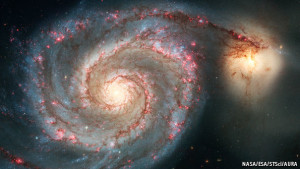 I have many questions about basic facts of the universe, from “What is sleep for?” to “How do Mirrors Work?” It’s a long list. I’ve attempted to find answers to these questions over the years, unsuccessfully. Usually it’s because I can’t make the question clear to anyone, or I can’t understand the answer.
I have many questions about basic facts of the universe, from “What is sleep for?” to “How do Mirrors Work?” It’s a long list. I’ve attempted to find answers to these questions over the years, unsuccessfully. Usually it’s because I can’t make the question clear to anyone, or I can’t understand the answer.
One of these perennial questions came up again for me in an article on black holes in a recent edition of The Economist (January 9th, Science and Technology section: Astronomy). My question is not about black holes although those are plenty mysterious. My question is much simpler: Why do spiral galaxies have spiral arms?
If you look at a picture of a spiral galaxy, and there are many of them from Hubble (our own Milky Way is a spiral galaxy), they look like pinwheels. But that’s impossible. There would have to be some inertial resistance operating on the arms to prevent them from spinning as fast as their core.
Space is a vacuum, so what is the equivalent of the wind resistance that would force jets, or tendrils, or tentacles of stars to be swept back into spiral form? (The whole question of why astronomical objects spin in the first place is another question – to be deferred).
Maybe space is not a vacuum. There might be an environment of tiny dust particles that could constitute the “atmosphere” that puts up the drag to oppose the spinning of the object’s arms. But I doubt that. It would be too thin, and besides, the arms of the galaxy ARE the dust. That’s exactly where star formation is taking place by accretion. There’s no reason to believe that the empty space around a galaxy is thick with enough matter to force a starburst shape to become a spiral shape.
Assuming the stars in the arms are falling into the spinning core, it makes sense that the ones farther out are not falling as fast as the ones closer in, so I have no problem with the tapered shape of the arms. The problem is why the spinning of the core should have any effect on the arms. I would expect to see something like a regularly gradated cloud of stars around the cord, denser near the center lighter at the edges – in other words, a non-spiral galaxy. I would not expect to see a pinwheel.
A few years back, I asked a prominent University of Arizona astronomer this question, and I think I made myself clear, but I couldn’t understand his answer. He said those spiral arms are not really there. It’s a perceptual illusion. New stars are being formed at the tips of the arms while old stars are being consumed near the core, and the differential timing of that process gives the illusion of a spiral. That’s what he said.
“Do you understand?” he asked.
“So you’re saying the spiral arms I am questioning are not really there so I have no question?”
“Yes, that’s right.”
Well, I have to say, that answer just didn’t do it for me. I get that my analogy to a pinwheel in an atmosphere might be off-base, but to say that “Your question is not legitimate,” is not a good answer to any question, at least not without a lot more explanation.
So I read the article in The Economist with great interest, but my eyes kept going back to the picture. I still have questions.
